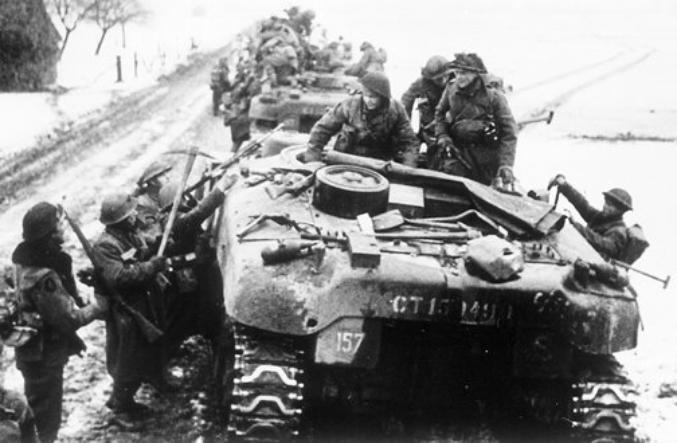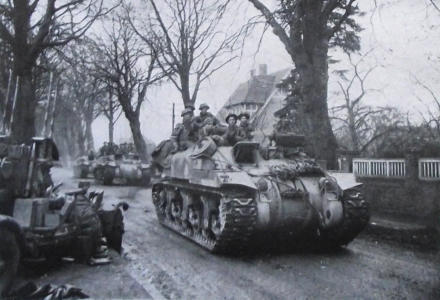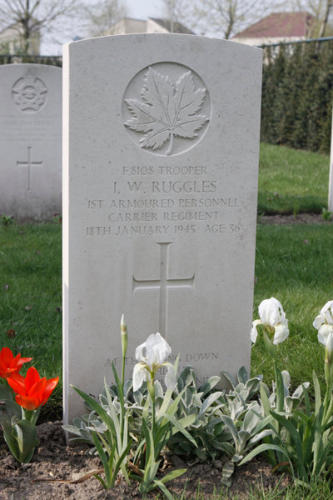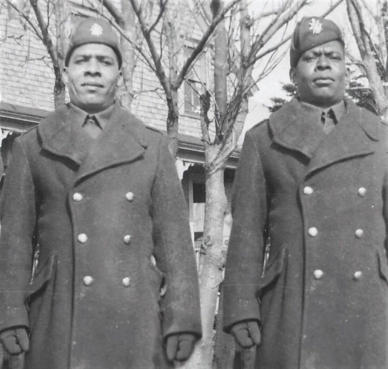
copyright © Wartime Heritage Association
Website hosting courtesy of Register.com - a web.com company
Wartime Heritage
ASSOCIATION
Remembering World War II

Name:
Rank:
Service Number:
Service:
Date of Birth:
Place of Birth:
Date of Enlistment:
Place of Enlistment:
Address at Enlistment:
Age at Enlistment:
Height:
Complexion:
Eye Colour:
Hair Colour:
Martial Status:
Trade:
Religion:
Next of Kin:
Date of Death:
Age at Death:
Cemetery:
Grave Reference:
Isaac Wilkins Ruggles
Isaac Wilkins Ruggles
Trooper
F/445098
F/8108
Royal Canadian Armoured Corps
1st Canadian Armoured Carrier Regiment
(Kangaroo Regiment)
August 12, 1908
Lequille, Annapolis Co., NS
June 25, 1942
Yarmouth, NS
Yarmouth, NS
32
5 feet 10½ inches
Colored
Black
Black
Single at enlistment
Gardener, Houseman, Janitor, Butler
Church of England
George Ruggles (Brother) Lequille, NS,
Barbara Ruggles (Wife) Yarmouth, NS
January 18, 1945
36
Nederweert War Cemetery, Limburg, Netherlands
IV. C. 11.
Commemorated on page 560 of the Second World War Book of Remembrance
Displayed in the Memorial Chamber of the Peace Tower in Ottawa on November 23
Isaac was the son of James Wallace Ruggles (1855–1936) who had died prior to WWII at the age of
80, and Minnie Fowler Ruggles (1866–1908), who also predeceased her son at the age of 65. Isaac had 4
siblings alive at the time of his enlistment and more than 10 other brothers and sisters who predeceased
him.
His brother, James J. Ruggles, also served with the West Nova Scotia Regiment in WWII. His sister
Edna lived in Montreal, QC, his older half-brother, George in Lequille, NS, and a half-sister Maude living
in Boston, MA, USA.
Isaac’s deceased brother Harry’s sons Harold and Donald Ruggles served in the Canadian Army
overseas and survived the war.
Isaac was the husband of Etta Barbara Robinson Ruggles, of Halifax, Nova Scotia. She was born July
7, 1907, the daughter of Albert and Clara (Fowler) Robinson.
His enlistment records of 1942 read, “Ruggles has been employed in the Officer’s Mess at this
training centre for the past three years. A man of high integrity and excellent deportment. Subject,
during evenings at Yarmouth has studied motor mechanics and would prefer this work within the
army... Ruggles has a great deal to bring to the Army service and will be an asset to any unit.”
It is further noted October 15, 1943 that he, “enlisted July 15, 1940 and the served in Officers
Mess at Yarmouth because of civil experience as butler. Had Basic Training at Yarmouth at end of 1942
and a 4 week course at New Glasgow in Aug-Sept 1943. He was Mess Corporal at Yarmouth Jan-Aug
1943. Age 35, cat, A1. Married. Height 5'10". Weight 200. This very likable man, has a good conduct
record and as a credit to his race. He took a civil course at Motor Mechanics while at Yarmouth and
wishes to carry on with D. & M. [Driver and Mechanics] for which he seems well suited.”
He had previously served with the 2nd Battalion, West Nova Scotia Regiment beginning August 1,
1940. His records indicate he was employed at Canadian Army Basic Training Centre No. 60 (Camp 60 in
Yarmouth, NS) as of September 9, 1940 until August 29, 1943.
During his tenure at Camp 60, he married Barbara Etta Robinson on July 5, 1941, at the Holy
Trinity Church in Yarmouth, NS.
From Yarmouth, he transfered to Canadian Army Basic Training Centre No. 61 in New Glasgow, NS,
for Basic Training from August 30, 1943, to October 5, 1943. He then transfered to A2 Canadian Artillery
Training Centre, Camp Petawawa for additional training until March 25, 1944 where he qualified as
driver and mechanic for wheel and track vehicles. He served in Canada until March 25, 1944, in the UK
from April 1 - July 17, 1944, disembarked in France July 18, 1944 and served in Northwest Europe until
January 18, 1945.
He served in the 1st Canadian
Armoured Personnel Carrier
Regiment. His unit operated Ram
Kangaroo Armoured Personnel
Carriers, which were converted
obsolete Ram tanks.
Trooper Isaac Wilkins Ruggles
was killed January 18, 1945, as the
2nd British Army (then also including
the 1st Canadian Armoured
Personnel Carrier Regiment), chased
the last of the Germans out of
Southeast Holland and back into
Germany.
From the War Diary for 18 January 1945, 1st Canadian Armoured Personnel Carrier Regiment:
At 0400 hours, the mobile reserve with ‘A’ & ‘B’ Companies, 2nd Battalion, Devonshire Regiment
in Kangaroos moved along Green route to reinforce ‘D’ Company, 2 Devons in Echt (Netherlands).
At first light, an attempt (with ‘C’ Company, 2 Devons in a section of 3 Kangaroos was made on
the main road (Susteren – Schilberg)). This was stopped by a roadblock at Map Reference 695776 which
was covered by enemy self-propelled gunfire. Another attempt was made to run past block with this
section of kangaroos at 1345 hours (1:45 pm) but once more S.P. fire smashed the attempt but the
vehicles, fortunately, got out. The infantry commander realizing the kangaroos were of no further
value released them and they regrouped back in Dieteren.
The Kangaroos were not used again until 1100 hours when (British) 9th Battalion, Durham Light
Infantry there brought up from Dieteren to relieve the 2nd Devonshire Regiment. During the interim,
the Kangaroos were used for ferrying prisoners, rations and evacuating wounded. (Mortar fire had been
quite heavy during the day and one man was killed, Trooper Ruggles)
A veteran interview undertaken by the Kangaroo Regiment Archive in 2005, provides additional
detail:
“As Trooper Harold Thompson recalled, the regiment had just come back from carrying infantry
and were parked for a rest at the edge of a farm field. Most of the men went out in the field and were
exploring some German vehicles that had been abandoned there, especially a German motorcycle. Isaac
was one of a few men remained back with the tanks. Alone in his tank, he went to sleep there. Isaac
was a Driver/Mechanic, an exhausting job at the best of times.
At this time, German mortar bombs were falling ever closer to the field. As Thompson recalls,
they were used to the constant mortaring and were not too concerned, no tanks were moved right
away. It was some time, before the men in the field went back to their tanks, having enough fun with
the motorcycle and deciding the bombs might be ranging in on them. When they returned Ruggles was
found dead, no wounds were evident. It was determined he had died from the shock wave of an airburst
above or near the open-topped tank.”
Trooper Isaac Wilkins Ruggles is buried in the
Nederweert War Cemetery, in Limburg, Netherlands.

Image of infantrymen of the 2nd Battalion, Devonshire Regiment, of 131st British Infantry Brigade, loading
onto ‘Ram’ Kangaroo armoured personnel carriers of “B” Squadron, 1st Canadian Armoured Personnel Carrier
Regiment, near Dieteren, Holland, January 15, 1945



Brothers, James and Isaac Ruggles. (Isaac on left)


- World War I - Menu
- WWI Stories and Articles
- Photos - Yarmouth Soldiers
- Selection of World War I Songs
- WWI Casualties of Yarmouth, NS
- Those Who Served - Yarmouth, NS
- WWI Casualties Digby Co. NS
- WWI Casualties Shelburne Co. NS
- Merchant Mariners (1915) Yarmouth, NS
- Canadian Forestry Corps - Non Yarmouth Birth/Residence Enlistments
- US Draft Registry - Yarmouth NS Born


- World War II - Menu
- WWII Stories and Articles
- Telegraphist Air Gunners
- WWII Casualties of Nova Scotia
- US Casualties with NS Connection
- Far East/Pacific Casualties with NS Connection
- Merchant Navy Casualties Nova Scotia
- Nova Scotia WWII Casualties Holten Canadian War Cemetery
- D-Day Casualties - Nova Scotia
- CANLOAN Program Casualties - Nova Scotia
- Battle of the Bulge Casualties - Nova Scotia
- WWII Casualties Yarmouth NS
- Yarmouth Casualties - RCAF RAF Canadian Army WWII
- Yarmouth Co., Marriages WWII
- Casualties Non-Born/Residents with Connection to Yarmouth Co., Nova Scotia.
- WWII Casualties Digby Co., NS
- Non-Nova Scotian WWII Casualties Buried in Nova Scotia
- WWII RCAF Casualties Aged 16-18
- Brothers/Sisters Who Served - World War II














